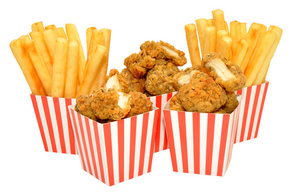French fries
I read an article in Scientific American regarding the science behind French Fries. Yes, that is correct -- the science of French Fries. Have you ever used raw potatoes to make French Fries? Initially, the first few batches turn out terrible, as they just don’t get crispy. It’s not the hot oil that creates the crispy outside. When fries are continually being prepared all day, the starches and sugars from the potatoes seep out into the oil. The hot sugars are the responsible party for making the fries crispy. In the old days, oil was expensive and French Fries were considered a holiday treat. Preparing them was only worthwhile if a large number of people were eating, requiring recurring batches to be made. When ordering fries today, your batch may be number 2,000.
Ice cream
Before refrigeration was available, making ice cream required cream, sugar, flavoring, ice, rock salt and lots of energy. The ingredients were mixed and put into a special bucket surrounded by ice and rock salt to reach below freezing temperatures. Someone would turn a crank to mix the ingredients, keeping it frozen to make a smooth consistency and to keep the ice crystals small. In those days, attending a July 4 picnic would require the job of many teenagers to consistently turn the crank. Ice cream had to be eaten the same day (there was no way to maintain below freezing temperatures during the summer and required lots of time and exertion). Everyone got a little treat and then it was gone. In Henry David Thoreau’s book Walden Pond, there is a chapter describing how ice was made in the summer months. In the dead of winter, ice was cut from the pond and stored under straw to last into summer. Ice cream was a very rare treat for special occasions.
Fried chicken
Fried chicken has some similarities to French Fries. Oil was expensive and would never be wasted on a single meal to feed a handful of people. If you have ever made it, you recall the messy process including splattering grease all over the kitchen — it usually was reserved for a group project. After church on Sundays, folks often gathered for lunch and heaps of chicken would be prepared for the entire group. Because many women participated in this messy endeavor, it required a shorter amount of time to clean up afterwards. Again, fried chicken was made on occasion (not daily) and was considered an indulgence.
Barbecue and burgers
To barbecue food, it used to require special equipment. A large griddle was needed for the burgers and a smoker for the barbecue. It entailed loads of work and was saved for a weekend treat or event. The alternative was to meet at an urban location where smoked meat could be sold to a large number of customers.
Soft drinks
At one time, producing soft drinks required an industrial plant to make carbonated water and sugar syrup was costly. When I was young, Coca-Cola came in a six-ounce bottle and the average person usually drank a single bottle serving. The familiar drugstore fountain wide top Coca-Cola glass had a tiny bottom. It contained only five ounces of liquid plus ice. Now, it can be purchased in 36-oz cups and two liter bottles — many restaurants happily offer free refills.
Many of Michael Pollan’s books point out that fast foods today have become regular staples of the American diet. These infrequent, tasty, naughty, high caloric treats are now part of a daily diet that has markedly increased the caloric intake of the average American.

 RSS Feed
RSS Feed